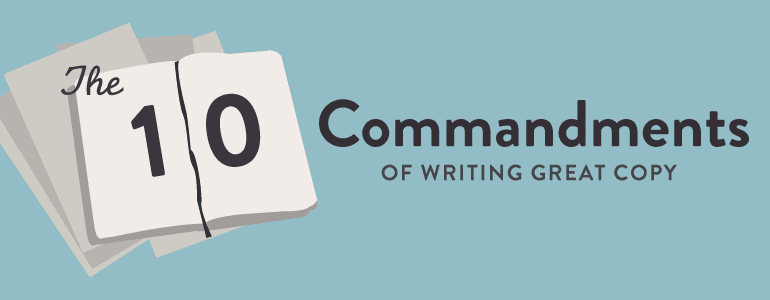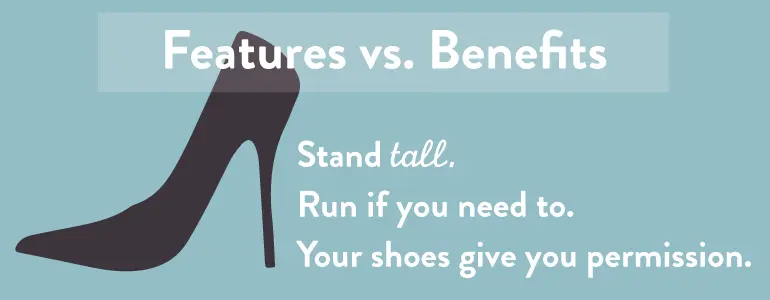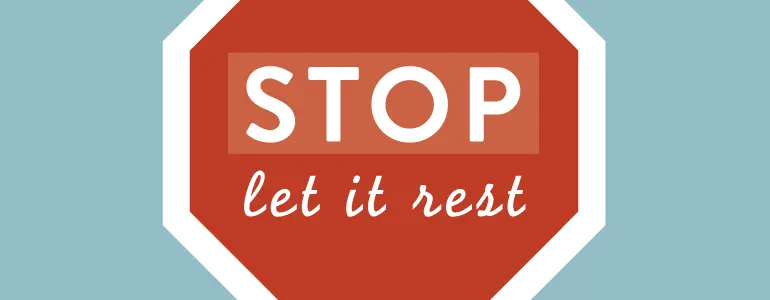The 10 Commandments Of Writing Great Copy
 What does it take to write great copy?
Great copy looks different depending upon where you find it; each audience has a different set of copywriting rules that they respond to. Great blog copy might make terrible ad copy, and vice versa.
So let's talk about the copy you're creating for your website and blog. What rules apply?
What does it take to write great copy?
Great copy looks different depending upon where you find it; each audience has a different set of copywriting rules that they respond to. Great blog copy might make terrible ad copy, and vice versa.
So let's talk about the copy you're creating for your website and blog. What rules apply?
1. Write as a conversation.
People prefer conversations rather than lectures. Lectures talk down to them, while conversations speak with them on the same level. How do you write conversationally? There's a real human here. When I write, I have a specific person in mind as I write. I need a face to write to, or I write generic, faceless posts. This approach keeps me from acting as if I am lording over a reader, but sitting next to her and having a conversation about something. Perhaps it is a fan on Twitter or a reader who left a comment who I am thinking of when writing. This is made easier when you listen to your audience's feedback and write posts that they request or suggest. Second person over there.
When you illustrate with a real-life example, it's OK to use the first-person (I, me, we). For the rest of your post, use second person (you, yours). Grammar says no, don't mix the two, but think of how you carry on a conversation.
"You should stay away from skunks."
"Why?"
"I had a bad experience once. Thought it was a cat. You really want to avoid that."
You can mix the two in your blog copy if you reserve "I" for your examples and stories, and "you" for the rest. The point is to be conscious of it, and not sloppily mix "we" and "you" from one paragraph to the next when no illustration or personal story is involved.
Second person over there.
When you illustrate with a real-life example, it's OK to use the first-person (I, me, we). For the rest of your post, use second person (you, yours). Grammar says no, don't mix the two, but think of how you carry on a conversation.
"You should stay away from skunks."
"Why?"
"I had a bad experience once. Thought it was a cat. You really want to avoid that."
You can mix the two in your blog copy if you reserve "I" for your examples and stories, and "you" for the rest. The point is to be conscious of it, and not sloppily mix "we" and "you" from one paragraph to the next when no illustration or personal story is involved.
2. Don't fall in love with your pets. Kill them.
You have pet phrases that you love. These are the ways of handling words and ideas that you return to again and again. Maybe you are like Ronald Reagan, and prefer to start everything with a "well,..." Your pets have been loyal and served you well and you don't even notice them anymore, but not everyone who visits your blog appreciates your dog jumping up on them and slobbering all over their face every paragraph or so. During the edit process, look for the "so, but, well, therefore" that don't need to be there. You'll often see them at the start of a sentence. Look for the larger phrases, too.3. Make friends with simplicity.
Simple is good. If churning out copy is what you do all day, you'll find it easy to bloat your writing. Words are what you think of and write all day long, and when weariness seeps in, your copy starts to bloat because it is more difficult to write simple sentences that it is to write long sentences.When you are tired of writing, your copy gets bloated. Simple writing takes more work.
Click To Tweet- Speaks plainly and directly. Says what it means to say.
- Not laden with gimmicks, either in words or ideas.
- Has breathing room, both in white space on the page and the sound of the sentences (mix short with long sentences).
- Clear ideas. No meandering around.
- Skips jargon and impossible words that make readers feel stupid when they don't understand.
4. Write to sell.
All writing is selling. It pains me to say that out of fear of being crass, but even fiction writing is selling. It sells an ideology, a philosophy, a fantasy, a hope, a chance. You have to know what you are selling with your copy before you can write the copy.All writing is selling. It sells a product, an idea, or even hope.
Click To Tweet
5. Know the difference between features and benefits.
You can think of this as knowing your value proposition, but terminology like that buzzes right by me. (Avoid buzz words wherever possible.) Are you selling a beverage or are you selling a lifestyle? Are you selling ebooks on entrepreneurship or are you selling hope? Are you selling watches or are you selling an identity? It's easy to mistake selling widgets as being about the widget itself instead of what it does in the life of the person using it. The features might not be the point. Let's say you are selling shoes. Your latest creation makes people appear taller because of ingenious heel design, while still allowing them to easily run and not lose balance despite the boost. This is great news for shorter people everywhere. When you talk about this shoe in your copy, you discuss these traits. Our shoe uses a patented heel design that gives you additional height while keeping you firmly gripped to the ground. Unfortunately, you missed an important selling point. The added height without damage to mobility makes wearers of the shoe more confident and in control. They don't care about the heel design, or that they won't fall. They want to hear about the new-found confidence the shoe will give them at their job and in life. Stand tall. Run if you need to. Your shoes give you permission. Step back from familiarity. Understanding the difference between features and benefits was (and is) a struggle for us here at CoSchedule. It is easy for us to get carried up into a listing of powerful features rather than writing about what really attracts people. I still slip into the habit of feature listing. "We connect to your WordPress blog, publish to social media, and it's all easy to see and plan on a calendar," I say. "So you'll give me back more time in the day, then?" you say. When you are so close to the product, it is difficult to see it what it really offers to an outsider who sees it for the first time. One of the most valuable sources of understanding what we are really offering is listening to our customers and what they tell us. If you aren't sure what your product or service is other than the features it has, let people try it out and ask them questions. Listen for key phrases or ideas that come through. "How does wearing our shoes make you feel?" you might ask your customer. Because without asking, would you ever find out that a shoe wasn't about a shoe, but was about confidence instead?6. Find an angle that works.
From which direction will you approach what you are writing about? What will be your angle of attack? There are two ways to think of this idea of finding an angle. Writing from different directions. It's what I call "prepositional phrase" thinking. Here sits your topic in the middle of the room. Will you write about it from above? From the inside? On it? Next to it? Around it? A practical application of this might be whether you write about your widget as an industry insider, a newbie experiencing it from the outside for the first time, or as a patient teacher there to broaden readers' horizons. Who you are selling to will determine the direction you choose to write from. If you're writing to industry insiders, you won't write as if for newbies. Your language and depth will reflect this. Choose how you will appeal. At the end of your writing, you are expecting the reader to do something. You are making an argument with your copy, and should therefore consider which argumentative appeal you will use to get readers to act. Your appeals will either use ethos, pathos, logos, or kairos.- Ethos: Appeal to the reader by establishing your credibility. Your writing shows you can be trusted, and are an authority.
- Pathos: Appeal to reader emotions. Capitalize on their sensitivities. Make them laugh, cry, or feel outrage. Use sensory details. Make them feel something, anything.
- Logos: Appeal to the reader's logical side. Show you have facts and logic on your side. Present the data and statistics that shows you have proven your idea.
- Kairos: Appeal to the reader's sense of time. Show that now is the time to act.
7. Don't slap your audience with your copy.
There is something called the "SLAP rule", which stands for: Stop, Look, Act, Purchase. Yes, but. There is no need to abuse your audience. No one really wants to be slapped, which is what you do if you get people to stop and look by using shock or trickery. You are vying for the attention of an audience already being bombarded by blog posts, email newsletters, "sign up now!", and everything under the sun. They are being SLAPped left and right. Readers and copy shock tactics are like bacteria and antibiotics. A certain level of resistance and desensitization happens. You keep upping the ante in your copy, and you soon won't have anything left. What works are the basic, most simple motivations:- The psychology of exclusivity.
- Being genuinely honest. It's so rare, it's almost shocking. People are attracted to it.
- Genuine persuasion that has the courage to stand behind and make promises about a product or service that actually works.

8. Stop when you need to.
Quotas are dangerous to writing. If you don't have enough information to share to fill the quota, what happens? You'll break every commandment here in order to fulfill a too-big quota, in order to hit a word count, a page count, a list count. You'll write bloated copy, mushy phrases, meandering ideas, and attack from multiple angles all in one chunk of copy. How do you know when to stop?- When you're only writing to meet word counts.
- When you've said all you need to say.
- When your writing is tight and direct.


